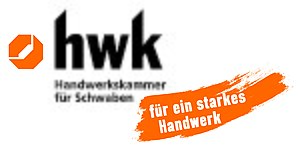Chamber of Crafts for Swabia
| Chamber of Crafts for Swabia | |
|---|---|

|
|
| chamber | |
| Organizational form | Public corporation |
| founding year | 1900 |
| Seat | Augsburg (Siebentischstrasse 52-58) |
| Homepage | www.hwk-schwaben.de |
| Chief Executive | Ulrich Wagner |
The Chamber of Crafts for Swabia is one of 53 chambers of crafts in the Federal Republic of Germany and is based in Augsburg . It represents around 29,000 member companies and deals with the areas of self-administration and lobbying. The official statistics assign about 141,000 employees to the craft in Swabia, 11,000 of them trainees. These generate sales of 15.4 billion euros.
The Chamber of Crafts for Swabia ensures that the concerns of all Swabian craftsmen are represented jointly and in solidarity in politics and the public. It fulfills sovereign tasks, for example the management of the craft and apprenticeship role, the supervision of training, the examination and expert system as well as the legal supervision of the Swabian district craft associations and guilds. The Chamber of Crafts offers advice to its members in the areas of business administration, craft law, law and technology. The range of services includes all areas of everyday business - from A for labor law to U for environmental protection .
The Chamber of Crafts for Swabia is also available to entrepreneurs, employees and apprentices as well as young people and their parents in the field of training and further education. It maintains five training centers in Augsburg, Bad Wörishofen , Kempten , Memmingen and Weißenhorn . As one of the largest providers of advanced training in the region, the HWK Schwaben offers numerous courses and seminars there.
The Chamber of Crafts is a corporation under public law that provides a variety of tasks, services and services for its members. These tasks are stipulated by law in the craft regulations.
organization
The members of the Chamber of Crafts for Swabia send their representatives to the General Assembly , which consists of 45 people. Of these, 26 are self-employed craftsmen from companies listed in Annexes A and B1 (see Crafts Code), four are owners of companies in the craft-like trade (B2) and 15 employee representatives , of which 14 are in companies of self-employed craftsmen in Annexes A and B1 and one in a company similar to craft trades Business (B2) must be employed.
The management, which consists of full-time employees of the Chamber of Crafts, is also elected by the general assembly. The board is responsible for the administration of the Chamber of Crafts. It consists of twelve members who are elected from the center and by the general assembly. The committee consists of the president, the two vice-presidents and nine other board members. Two thirds of the members of the board are employer representatives and one third are employee representatives. The President of the HWK is always the employer representative. Of the two vice-presidents, one belongs to the employers' group and the other to the employee group. The Chamber of Crafts is represented externally by the President and the General Manager.
history
Many generations of Swabian craftsmen shaped the economic, social and political development in today's Chamber of Crafts district of Swabia. When the Chamber of Crafts for Swabia (until 1937: Chamber of Crafts of Schwaben and Neuburg) was founded in 1900 based on an amendment to the trade regulations of 1897, the craft businesses in Swabia found new professional cohesion 100 years after the guilds dissolved. JN Mederle was the founding chairman. In the founding year there were 53 guilds.
At that time, it was primarily a matter of regulating the long-standing questions of professional organization and practice as well as of the vocational education system. One of the first activities of the Chamber of Crafts was the development of regulations to regulate the apprenticeship system. This created the prerequisites for working for the interests of the member companies and for creating the opportunities for the Swabian handicraft to participate within society that it is entitled to due to its dynamism and its economic efficiency. In addition to all the job-specific innovations, the aim was also to promote the motivation of the craftsmen. For this purpose, from 1911 onwards, awards were given to all journeymen who had been with the same company for at least 20 years without interruption.
During the war, the Chamber of Crafts for Swabia worked out special apprenticeship contracts for war invalids, which were taken over by the other German Chambers of Crafts. The chamber building on Schmidberg was completely destroyed in the night of bombing in February 1944. After the end of the Second World War, the reconstruction and expansion of the building began.
The law on the new delimitation of the administrative districts of December 27, 1971 resulted in some corrections in the area of responsibility and the streamlining of the organization. The majority of the old district of Aichach was assigned to the administrative district of Swabia, while in return the majority of the former district of Neuburg / Danube came to the administrative district of Upper Bavaria.
At the beginning of the eighties, the Chamber of Crafts for Swabia refurbished and renovated the fountain master's house of the city of Augsburg in accordance with strict monument preservation guidelines. Under the sponsorship of the Chamber of Crafts for Swabia, it now houses the Swabian Crafts Museum .
Web links
- Homepage of the Chamber of Crafts for Swabia
- Training centers of the Chamber of Crafts for Swabia
- Swabian Crafts Museum
Individual evidence
Coordinates: 48 ° 20 ′ 56 ″ N , 10 ° 55 ′ 4 ″ E